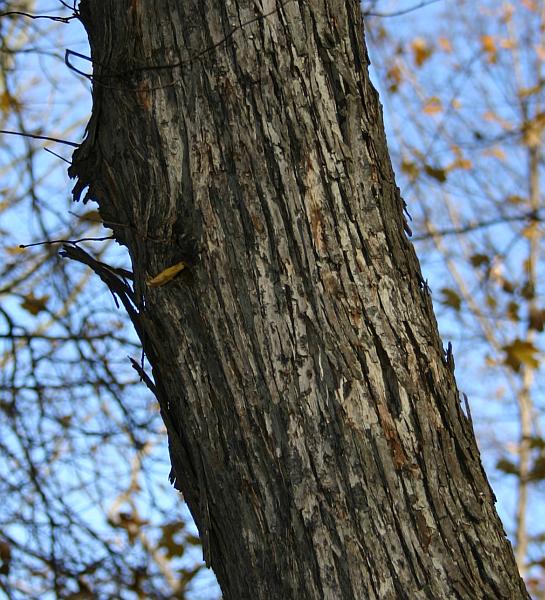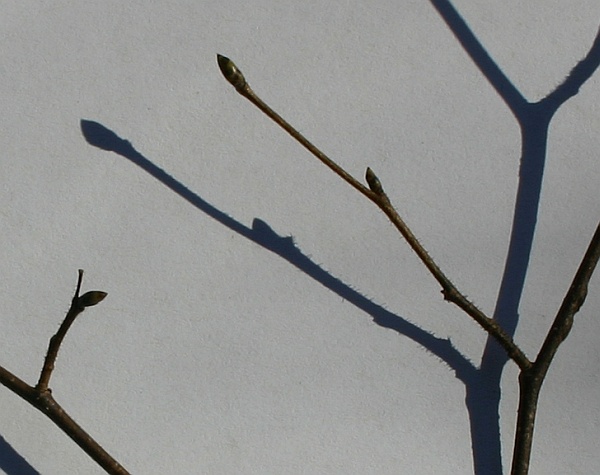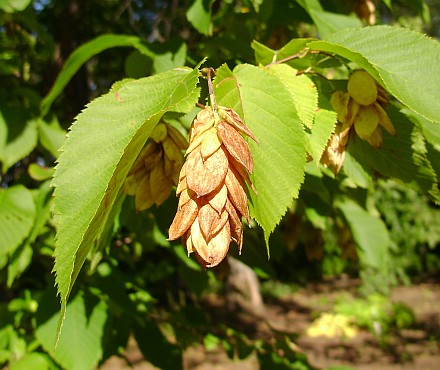
No matter how you look at it, this tree has confusing names. My Winter Tree Finder calls it ironwood (it doesn’t even list the hophornbeam name!), but as I learned last weekend ironwood is an alternate name for at least two other trees.
Ironwood’s official name is eastern hophornbeam (Ostrya virginiana). It’s a common tree in the birch family, most easily recognized by its bark which has long, square-edged strips that peel upward.
Hophornbeam wood is very heavy, hard and strong, so durable that when metal was scarce this wood was used to make wheel rims and sleigh runners. “Horn beam” means hard wood. “Hop” refers to the tree’s fruit which resembles hops (think beer). Here’s what the fruit looks like:
A closely related tree, the blue beech (Carpinus caroliniana), also carries the hornbeam and ironwood names. Blue beech’s official name is American hornbeam without the “hop.” Its bark looks very different: smooth, blue-gray and muscular. This earned it the nickname “musclewood.” Click here to see blue beech bark.
Since hophornbeam is in the birch family, its twigs look very “birch-y” and often carry catkins. From experience with the Winter Tree Finder, I can tell you it takes a long time to key out this twig. I recommend identifying the tree by its bark.

Ironwood and ironwood, hophornbeam and hornbeam. I’ll keep them straight by calling this one hophornbeam (or ironwood) and the other one “blue beech” instead of its confusingly similar hornbeam name.
(Bark and twig photos by Kate St. John. Hop-like fruit photo from Wikimedia Commons. Click on the hops photo to see its original.)

Thanks for the pictures and details. A master gardener neighbor and I were puzzled about a native small tree that had its seed pod attached (June 2013). I broke a small branch off to help me serarch. She thought it was a bit along the lines of the hop. I couldn’t locate it in her Hillier’s Tree Guide. So I have spent all morning googling various sites…yours was one of the last…Eureka! It’s an ironwood or American hopshornbeam tree! We have a local ironwood spring near here…probably named for this tree native to our area…common all over it seems…Hot Springs Village in the Ouachita Forests of Arkansas.
the beechnut trees are related to the oak tree family
not the birch family and the hornbeam trees are related to the
beech-trees right i do have a book that does say in it that beech
is in the oak family because of its seeds.
but it looks to me like we are talking about different verities of trees
you say they call um blue beechnut trees and hop-hornbeam trees
and the beech trees around here grow mainly wide trunks the bark
is usually gray with lichen on the bark and does usually have spots were
water collects where the branches v from the trunk
the hornbeam trees around here have bark that looks some what like
tulip tree bark or like walnut tree bark the leaves are ruff beech tree leaves are
smooth.
Mike, yes the beeches are oaks are related. The trees mentioned in this article (Hornbeam and Hophornbeam) are in the birch family. Here in western Pennsylvania we call the American Hornbeam (Carpinus caroliniana) a “Blue beech” because of its bark, but it’s not a beech tree at all.
The common names in this family are often confusing. After I wrote this article I learned that the name “Ironwood” is also applied to an unrelated tree.
Does anyone know where I can get Ironwood pieces or where is the best place to look for it and I can harvest it.
I have also noticed the confusion. Both of these being called ironwood. They are found in very different habitats. Blue beech liking wet areas and hophornbeam drier uplands. In eastern pa. I think more scarce.
I have found that in the forest of the Catskills, NY, the two trees are found very near each other. If I see one, I look for the other, and it usually isn’t far away.
I am trying to identify smaller tree in the woods of Ohio that keep their leaves in winter. They appear dry and light in color like parchment paper.
Kim, that’s an American beech tree. The younger/smaller ones retain their leaves until spring.
http://www.birdsoutsidemywindow.org/2011/12/21/winter-trees-american-beech/
Ostrya virginiana also hold their leaves through the winter, hophornbeam, similar to beech
Excellent explanation! I am currently taking the Indiana Master Naturist course and out last class was about tree Identification. I had to correct the naturalist about these trees. This is why the scientific name is so important.
Great article, this is such an interesting tree. We found one in our garden that has been there for years, but when it flowered this year we finally asked ‘What is that?’.
Thanks. I thought ironwood had the ripples of Carpinus caroliniana. Now I can think of one as splintery and the other muscley, ironwood and musclewood. They and beech are markedly different and have different genus names, Ostrya, Carpinus, and Fagus.
Wonderful! I have been trying to identify a tree in Dad’s property for an hour! The trees that used to block our view of this gem were felled by heavy winds this past spring. So the pods (hops) had been hidden until this summer. Thank you.
You have reassured me of the proper name.